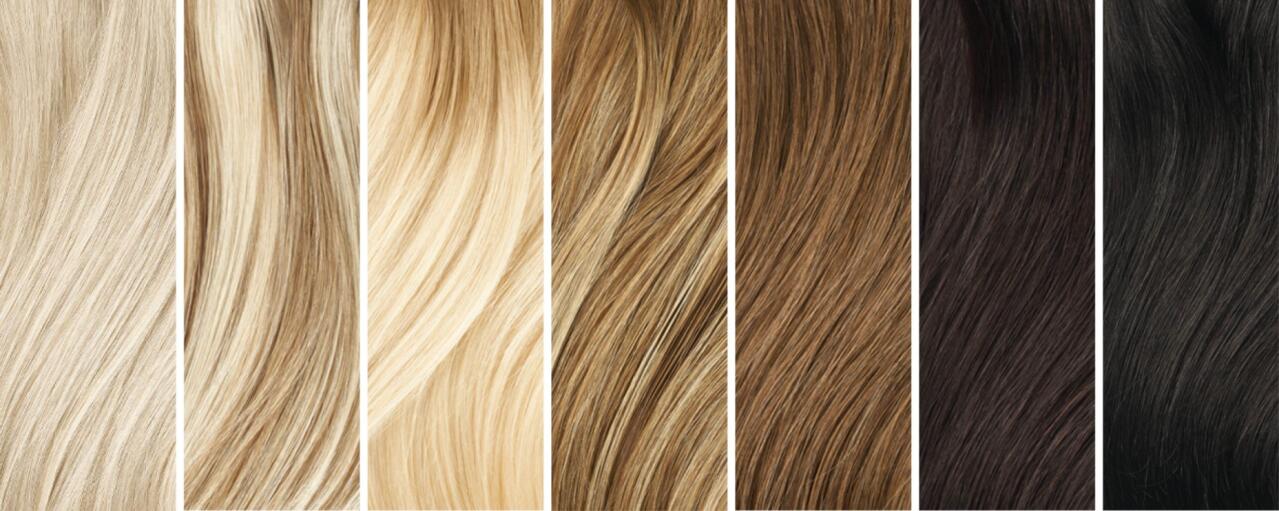Choosing a colour

Playing with hair colours, effects and shades of extensions is fun but also a great way to accentuate the natural undertones in your skin and the colour of your eyes. Finding the colour that is right for just you usually might take some time. We asked our hairdressers for the best way to find the perfect shade for your look and how to know when just that colour is the one true match.
First and foremost, the colour that you choose should be a colour you feel comfortable in. All the ground rules and trends are irrelevant if you don’t feel great with the colour. Feel free to use our tips as a guideline, but please don't let them limit your choices. In the end, you should of course choose the colour that you think will suit you best.
Warm, cool, or neutral skin undertones?
Your skin undertone can either be warm, cool, or neutral. If you have a warm undertone, then warm colours will suit you, like golden blond and warm, beige colours. Those of you with cool undertones match well with cooler hair colours such as ash blond, black or a cool brown shade. If you have a neutral undertone, you can wear most colours. Here are some tips to help you find out which skin undertone you have:
- Look through your jewellery box, if you have mostly gold jewellery, then you are most likely a “warm”-toned person. If you have mostly silver jewellery, then you are more likely a “cool”-toned person.
- If you have a scarf or some material at home in warm/cool tones, then you can hold it up against your face and see which colour suits you most.
- Check through your make-up, do you have warm or cool eye shadows? They can give a good indication.
- If you have lots of freckles or get freckles when in the sun, then you most likely have “warm” skin undertones. If your skin easily gets burned in the sun, you most likely have a cool undertone.
- Another advice is to look at the veins of your wrist. If they look blue/purple, you have cool undertones. If they look green, you have warm undertones.
- If you feel that it’s difficult to determine your skin undertone, you might have a neutral skin undertone.
When you found out which skin undertone you have (warm, cool, or neutral) and which type of colour suits your style best, then there are masses of shades of extensions to choose from. We have listed some warm and cool colours that match with warm and cool skin undertones. If you have a neutral skin undertone, you can choose both warm and cold colours.
Colours suitable for warm skin undertones
B5.3/8.0, B5.0/8.3, M2.3/5.0, 5.4
2.0, C1.2/5.0, 5.0, M5.0/7.4
Colours suitable for cool skin undertones
B2.6/10.7, 10.7, B5.1/7.3, C2.2/10.5
2.6, 6.12, 7.3, 1.2, 2.0, C1.2/5.0
Further things to consider when choosing a hair colour
- If you have light-coloured eyes e.g., light blue, then you can accentuate them by choosing quite a dark hair colour and vice versa. If you have green eyes, they can be accentuated with red/copper tones.
- If your skin has a pink shade, then red hair tones should be avoided. If your skin is more yellow, then avoid yellow hair tones. If you have beige skin tones, then most colours will suit you.
- Think about how much time and money you want to spend on your hair after the treatment. Choosing red colours will mean that you may have to touch your hair up at home. If you want to avoid any maintenance, then it’s best to choose a base colour that is as close to your own as possible. That way you also avoid regrowth showing.
- By mixing colours and shades of extensions, you can easily create effective shades in your hair and achieve a more natural result. Highlights are created by combining your hair colour with a slightly lighter shade of hair. Match the colour to the tips of your hair or choose a shade that is one step lighter than your hair colour if you want a lighter look. Lowlights are created by attaching slightly darker shades of extensions than your hair colour. Place the sections at the back of your head or blend them in where you think they are best suited.
- If you feel unsure about your options, we recommend consulting with your hairdresser for tips and advice regarding what is possible.
Good to know when buying extensions
Rapunzel of Sweden’s extensions are made of real hair, so they act like real hair. This means that the colour of your extensions will not always be exactly the same and may sometimes differ from the product images. Rapunzel’s hair comes from people with different hair qualities and thus has different dyeing possibilities. The dyeing is done by hand, so our extensions are unique craftsmanship.
Colours may also differ between premium and original (basic) hair. Premium hair is remy with the cuticle left on. The hair thus retains its shine and suppleness and is easier to dye to a uniform shade. On original (and basic) hair, the cuticle has been removed to leave the hair soft and manageable without tangling. This allows the hair to have slightly more nuances after dyeing. The nuances are perceived as natural and give a lively impression.
Need help?
Email a photo of your hair to our experts who will match your hair with the right shade.
To find your colour, you can also check our colour chart.
